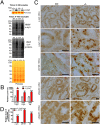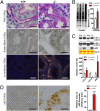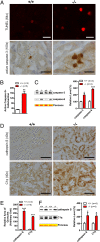Loss of leucine-rich repeat kinase 2 causes impairment of protein degradation pathways, accumulation of alpha-synuclein, and apoptotic cell death in aged mice
- PMID: 20457918
- PMCID: PMC2906862
- DOI: 10.1073/pnas.1004676107
Loss of leucine-rich repeat kinase 2 causes impairment of protein degradation pathways, accumulation of alpha-synuclein, and apoptotic cell death in aged mice
Abstract
Mutations in leucine-rich repeat kinase 2 (LRRK2) are the most common genetic cause of Parkinson's disease. LRRK2 is a large protein containing a small GTPase domain and a kinase domain, but its physiological role is unknown. To identify the normal function of LRRK2 in vivo, we generated two independent lines of germ-line deletion mice. The dopaminergic system of LRRK2(-/-) mice appears normal, and numbers of dopaminergic neurons and levels of striatal dopamine are unchanged. However, LRRK2(-/-) kidneys, which suffer the greatest loss of LRRK compared with other organs, develop striking accumulation and aggregation of alpha-synuclein and ubiquitinated proteins at 20 months of age. The autophagy-lysosomal pathway is also impaired in the absence of LRRK2, as indicated by accumulation of lipofuscin granules as well as altered levels of LC3-II and p62. Furthermore, loss of LRRK2 dramatically increases apoptotic cell death, inflammatory responses, and oxidative damage. Collectively, our findings show that LRRK2 plays an essential and unexpected role in the regulation of protein homeostasis during aging, and suggest that LRRK2 mutations may cause Parkinson's disease and cell death via impairment of protein degradation pathways, leading to alpha-synuclein accumulation and aggregation over time.
Conflict of interest statement
The authors declare no conflict of interest.
Figures




Similar articles
-
Loss of leucine-rich repeat kinase 2 causes age-dependent bi-phasic alterations of the autophagy pathway.Mol Neurodegener. 2012 Jan 9;7:2. doi: 10.1186/1750-1326-7-2. Mol Neurodegener. 2012. PMID: 22230652 Free PMC article.
-
Genetic analysis of Parkinson's disease-linked leucine-rich repeat kinase 2.Biochem Soc Trans. 2012 Oct;40(5):1042-6. doi: 10.1042/BST20120112. Biochem Soc Trans. 2012. PMID: 22988862 Free PMC article. Review.
-
Constitutive silencing of LRRK2 kinase activity leads to early glucocerebrosidase deregulation and late impairment of autophagy in vivo.Neurobiol Dis. 2021 Nov;159:105487. doi: 10.1016/j.nbd.2021.105487. Epub 2021 Aug 20. Neurobiol Dis. 2021. PMID: 34419621
-
Age-dependent accumulation of oligomeric SNCA/α-synuclein from impaired degradation in mutant LRRK2 knockin mouse model of Parkinson disease: role for therapeutic activation of chaperone-mediated autophagy (CMA).Autophagy. 2020 Feb;16(2):347-370. doi: 10.1080/15548627.2019.1603545. Epub 2019 Apr 14. Autophagy. 2020. PMID: 30983487 Free PMC article.
-
LRRK2 and Proteostasis in Parkinson's Disease.Int J Mol Sci. 2022 Jun 18;23(12):6808. doi: 10.3390/ijms23126808. Int J Mol Sci. 2022. PMID: 35743250 Free PMC article. Review.
Cited by
-
Inflammatory bowel disease: mechanisms, redox considerations, and therapeutic targets.Antioxid Redox Signal. 2013 Nov 10;19(14):1711-47. doi: 10.1089/ars.2012.4530. Epub 2013 Mar 1. Antioxid Redox Signal. 2013. PMID: 23305298 Free PMC article. Review.
-
Interplay between Leucine-Rich Repeat Kinase 2 (LRRK2) and p62/SQSTM-1 in Selective Autophagy.PLoS One. 2016 Sep 15;11(9):e0163029. doi: 10.1371/journal.pone.0163029. eCollection 2016. PLoS One. 2016. PMID: 27631370 Free PMC article.
-
Protein degradation pathways in Parkinson's disease: curse or blessing.Acta Neuropathol. 2012 Aug;124(2):153-72. doi: 10.1007/s00401-012-1004-6. Epub 2012 Jun 29. Acta Neuropathol. 2012. PMID: 22744791 Free PMC article. Review.
-
The cell biology of Parkinson's disease.J Cell Biol. 2021 Apr 5;220(4):e202012095. doi: 10.1083/jcb.202012095. J Cell Biol. 2021. PMID: 33749710 Free PMC article. Review.
-
LRRK2 and Lipid Pathways: Implications for Parkinson's Disease.Biomolecules. 2022 Oct 30;12(11):1597. doi: 10.3390/biom12111597. Biomolecules. 2022. PMID: 36358947 Free PMC article. Review.
References
-
- Spillantini MG, et al. Alpha-synuclein in Lewy bodies. Nature. 1997;388:839–840. - PubMed
-
- Paisán-Ruíz C, et al. Cloning of the gene containing mutations that cause PARK8-linked Parkinson's disease. Neuron. 2004;44:595–600. - PubMed
-
- Zimprich A, et al. Mutations in LRRK2 cause autosomal-dominant parkinsonism with pleomorphic pathology. Neuron. 2004;44:601–607. - PubMed
-
- Marín I. The Parkinson disease gene LRRK2: Evolutionary and structural insights. Mol Biol Evol. 2006;23:2423–2433. - PubMed
Publication types
MeSH terms
Substances
Grants and funding
LinkOut - more resources
Full Text Sources
Other Literature Sources
Medical
Molecular Biology Databases

